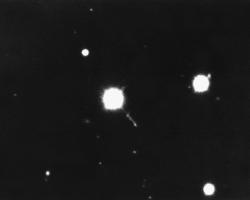

© CAMBRIDGE UNIVERSITY PRESS 1983, 1993
| |
1.5 Quasars
The term quasar is a short form for the full name ``quasi-stellar radio source''. Quasars were first discovered in 1963 as a result of the optical identification programme. The radio position of the quasar 3C 273 (see section 1.7 for the meaning of these catalogue numbers) was accurately determined by lunar occultation. If the Moon happens to cross the line of sight to a source, the source is said to be occulted. The drop in the intensity of a radio source as it is blocked by the Moon and the rise when the Moon has moved out of its way give accurate indication of when it is occulted and hence where it is located on the sky. The optical identification of this object (see Figure 1.16) and of another radio source, 3C 48, revealed starlike objects with emission lines, and it was originally assumed that these were radio stars in the galaxy. When their spectra were carefully examined, however, it became clear that the wavelengths were strongly redshifted.

|
Fig. 1.16. The quasar 3C 273. (Courtesy of Kitt Peak National Observatory.) |
If the wavelength of an emission line in the laboratory is  0 and if
the observed wavelength is
0 and if
the observed wavelength is  >
>
 0, then the line
is said to be redshifted by a fraction z given by
0, then the line
is said to be redshifted by a fraction z given by
It is usual to call z the redshift of the object. For
3C 273,
z = 0.158,
while for 3C 48, z = 0.367. (The word redshift
is used to
indicate a shift to the red end of the visual spectrum.)
These were high values of z for stars in the galaxy, which have values <
10-3. What were these objects? In 1964 Terrell suggested that
they were
high-velocity stars ejected from the galaxy. The more popular
interpretation, however, has been that the redshifts arise from the
expansion of the universe, a concept we will discuss in
section 1.8.
If this latter interpretation is correct, it implies that quasars are
very distant objects, and since from such large distances they look
bright enough to be mistaken for stars, they must be intrinsically very
powerful. Many quasars show rapid variation in their light and radio
output. This fact places a limit on their physical size; for if an
object shows variability on a characteristic time scale T its size must
be limited by cT, where c = the speed of light. This
limitation, arising
from the special relativistic result that no physical disturbance can
propagate with a speed > c, makes quasars very compact indeed. We saw in
section 1.2 how big our galaxy is. A quasar by
comparison may emit a
comparable amount of energy per unit time from a volume whose linear
extent may be only a few light-hours!
By now more than 5000 quasars are known. Only a few percent of the
total quasar population emit radio waves. Thus the early qualification
``radio source'' is not applicable to the bulk of the quasar population,
and although the term ``quasar'' is used today also for radio quiet
objects, the purist may prefer the term ``quasi-stellar object'' (QSO).
More recently, the X-ray astronomy satellite ``Einstein Observatory'' has
revealed that X-ray emission is also a common feature among quasars,
indeed is much more common than radio emission.
